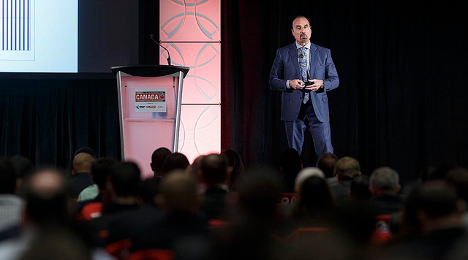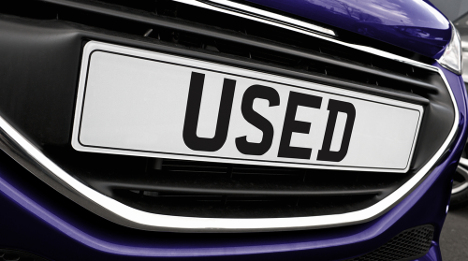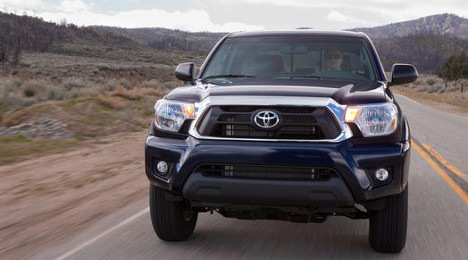Wind down the economic waterfall, and the impact of a higher Canadian interest rate to the used-car market is clear.
Canadian used-car prices will be heading downward, but the vehicles themselves will no longer be making that move.
An increased interest rate means a stronger Canadian dollar, and with less disparity between the U.S. and Canadian dollars, the proposition of exporting hundreds of thousands of cars to Canada’s southern neighbor becomes less appealing for the U.S. — resulting in lower used-car prices up north.
That’s the take of Canadian Black Book analyst Brian Murphy, who outlined these thoughts in a perspective the company provided to media.
Murphy, who is CBB’s vice president of research and editorial, was explaining the potential auto industry effects from the 0.25-percent interest rate bump that Bank of Canada Gov. Stephen Poloz revealed two weeks ago.
While touching on potentially higher new-car prices for consumers down the road, Murphy argues the more significant impact is the increased value of the Canadian dollar — which has already climbed $0.06 in the past two months, he said — and how that might impact used-car prices.
For starters, it drives down new-car sales, eventually slowing used-car prices, Murphy explains.
“As the strength of our dollar had been declining since 2013, U.S. interest in Canadian used vehicles increased,” Murphy said in the analysis. “Depending on who you ask, upwards of 200,000 vehicles have been being exported to the U.S. annually.
“U.S. buyers and/or Canadian exporters have been taking full advantage of a lower Canadian dollar and been moving vehicles across the border to sell at a higher price in the States versus here at home. This export demand has inflated our used-car prices domestically,” he said.
Fewer pull-aheads
Stronger used-car prices are motivation for dealers to get consumers out of their current lease or loan early, then sell that pre-owned unit at this elevated price and sell the customer a new car, he explained.
Also potentially at play, Murphy said, is that the very nature of high used-car prices mean more consumers have equity in their car, which gives the lease/loan “pull forward” activity more credence.
But don’t expect this to last, he said.
“At some point soon, the rising Canadian dollar and falling U.S. used vehicle prices will make it unattractive for U.S. buyers to purchase Canadian inventory in such large volumes,” Murphy said. “The impact to the Canadian auto industry will be a slowdown of ‘pull forward’ activity, as it won’t make economic sense to pull as many consumers out of their vehicles early because they won’t command such high prices on the used market.”
Lower prices all-around
The approximate “tipping point” where Canadian exports to the U.S. would decline dramatically is a $0.85 dollar, according to Canadian Black Book.
The gain in off-lease volume in the U.S. this year is around 500,000 units, Murphy said, also pointing out that Black Book’s U.S. used-car price index is down 10 percent year-over-year.
“The U.S. vehicle market is bracing for a large downward adjustment in used prices,” Murphy said. “Add in a stronger Canadian dollar, driving up acquisition costs, and there will be less demand in the U.S. for Canadian used vehicles.”
And eventually lower prices.
“On the positive side, Canadian used-vehicle shoppers and used vehicle dealers will be rewarded with better deals in the market compared to what they have seen over the last few years,” he said.
RVI Group’s Risk Outlook for June found that real used-vehicle prices in Canada decreased in May on a year-over-year basis. Analysts place the exact downward movement at just 0.4 percent.
When compared to April, the May softening was a bit more notable, as RVI Group pinpointed the dip at 1.5 percent.
Among higher volume segments, analysts found that full-size pickup prices increased the most on a year-over-year basis in May, ticking up by 6.9 percent. Meanwhile, sub-compact car prices decreased 5.9 percent on a year-over-year basis.
In May, the report noted the exchange rate was $0.73 USD/CAD, down from $0.74 USD/CAD in April. RVI Group also mentioned Canadian GDP grew in the first quarter to an annual rate of 3.7 percent from 2.6 percent in the fourth quarter.
However, the report recapped that new-vehicle sales declined, with a 1.87 million unit SAAR being recorded in the month of April.
“We expect that a stronger Canadian dollar, along with the growing supply of off-lease vehicles, will continue to put downward pressure on used-car prices, which are expected to decline by 9.0 percent from current levels by 2020,” RVI Group said in the report.
Mobials recently debuted Tradesii, its trade-in valuation tool for dealer websites that is powered by Canadian Black Book.
Tradesii was first launched in April as the exclusive on-site trade-in valuation tool for more than 3,000 dealers on Kijiji.ca.
More than 200 Canadian dealers have already signed on to the service, roughly over 3 percent of the Canadian dealer market, according to Mobials.
Mobials president Marty Meadows said that Tradesii is a truly Canadian experience.
“It is built by Canadians, for Canadian car dealers,” Meadows told Auto Remarketing Canada in a phone interview.
“This is probably the most important piece of it all, we use the No. 1 trusted brand for values, for Canadian consumers — Canadian Black Book. If you're searching Google, ‘What’s the value of my trade?’ what will come up in search is Canadian Black Book. So we partnered with the best brand with the best values, to hope the best consumer experience.”
Consumers visiting dealer websites fitted with Tradesii are offered the opportunity view their trade-in value in exchange for providing their contact information.
“It's valued for value,” Meadows added.
The Tradesii report also provides the average asking price of similar vehicles that are listed on CanadianBlackBook.com, allowing car shoppers to see what their current vehicle would list for at retail.
The lead and the specifics on vehicles searched for on Tradesii during car shoppers’ website visit is passed on to the dealer.
What dealers get from Tradesii is highly convertible leads that convert to sales, according to Meadows.
Meadows said his top dealer pulled 56 leads, and their ROI was 56-to-one.
“We are very happy with ROI thus far related to Tradesii. In comparison to our legacy trade-in calculator, I believe our web leads have increased tenfold and I know our Kijiji leads are up over three times,” Larry Hudson Chevrolet Buick GMC dealer principal Sean Hudson said in a Mobials news release.
“We have three dealer sites all using the tool and our issue now is fully capitalizing on the spike in leads, which is a good problem to have.”
For additional information about Tradesii and its specific offerings visit, tradesii.com.
CarGurus recently released a survey that found trust to be a leading factor for consumers when shopping for expensive purchases, such as cars.
“Survey respondents indicated that the car shopping process is very much in need of increased transparency if dealers are to win the trust of Canadian car shoppers,” the car research and shopping site said in a news release announcing the survey.
When asked which major purchases, such as a car, home, mortgage or event tickets yielded the most transparent information on price, CarGurus said: “only obtaining a mortgage (7 percent) fared worse than car buying (9 percent).”
More than a third of Canadians' trust in a seller fades away if the store price is greater than what they read advertised online, according to the survey.
23 percent of respondents said a detailed cost breakdown would increase their trust in a seller and 31 percent said they determine trustworthiness by word of mouth.
Consumers use both price information and customer reviews to make their opinions and decisions, the survey found.
Nearly half of Canadians rely on customer reviews to determine if a website is trustworthy, according to CarGurus.
Additionally, 40 percent of survey respondents said when researching expensive items online the appearance of both positive and negative customer reviews make the process more transparent and trustworthy.
"Establishing trust goes a long way with consumers, particularly those making big purchases," CarGurus senior vice president of consumer marketing Sarah Welch said. "In our experience at CarGurus, we've seen just how much transparency – providing reliable, easily accessible customer reviews, engaging with negative reviews and keeping updated price information across online inventory platforms – enhances the consumer shopping experience, and in turns benefits dealers."
How did used-car prices trend last month?
A pair of indices released this week sheds some light.
According to a report accompanying the ADESA Canada Used Vehicle Price Index — powered by ALG — there was a 0.12-percent month-over-month gain in wholesale prices.
Of the six segments included in the report, however, just two showed price growth for the month.
Mid-compacts were up 2.1 percent from March and full-size pickups were up 0.5 percent. The midsize segment was down 2.9 percent, minivans were off 8.6 percent, compact SUVs fell 1 percent and midsize SUVs dipped 0.2 percent.
Over at Cox Automotive, there was a 5.3-point dip in the Manheim Canada index. However, the index remained up by 1.8 points year-over-year.
Manheim Canada said the sports cars had the strongest monthly decline at 68.3 points. Most segments were down on a monthly basis, the company said, with the lone exception being pickups, which climbed 6.4 points.
Compact pickups had the greatest gain within that class, climbing 23.3 points.
The Ontario Motor Vehicle Industry Council announced it recently launched a province-wide multi-media campaign to increase awareness of all-in price advertising.
OMVIC said it started the campaign following research the council conducted that showed some Ontario car dealers continue to add additional fees to their advertised prices — though it is illegal and disadvantages law abiding dealerships.
“Since 2010 car-buyers have had right to all-in price advertising”, OMVIC director of communications and education Terry O’Keefe said in a news release. “That means dealers must include all fees, except HST and licensing, in any advertised vehicle price.”
The council said when dealers don’t include all fees it is unfair to car-buyers and non-compliant dealers get an unfair edge over dealers who advertise prices which include all fees and charges.
“If consumers know they have a right to all-in price advertising, they are able to protect themselves should they encounter non-compliant advertising,” OMVIC said.
The Ontario-wide campaign has used television, radio, online, billboard/transit and social media advertising to inform car buyers about advertising pricing.
OMVIC’s awareness initiative includes a TV commercial directed at consumers that says, “Buying a car? The fun is back! Ontario made all-in price advertising the law for Ontario car dealers — no more hidden fees. All-in price advertising: it’s your right!”
The campaign’s 15-second TV commercial along with a 36-second radio message is currently available on Youtube.
Below are examples of fees or charges that dealers must include in an advertised price, according to OMVIC.
- Freight
- PDI-PDE (pre-delivery inspection/expense)
- Administration (Admin) fee(s)
- Government levies (air tax, etc.)
- Safety and e-test (unless the ad contains a mandated "Unfit Vehicle" or "As-Is Vehicle" statement)
For more information on all-in price advertising, visit OMVIC’s website.
It won’t be a drastic change by any stretch, but Canada appears headed toward a modest softening in used-vehicle pricing.
And like the U.S., that dip is expected to be more pronounced for cars than for trucks.
As it stands, the market has been fairly solid and steady.
In a presentation here last week at the Auto Remarketing Canada Conference, KAR Auction Services chief economist Tom Kontos shared a fairly positive outlook on Canada’s overall economy and auto industry, including the used-car side.
The country’s new-car sales appear headed for a 1.9-million- to 2-million-unit year, which Kontos found to be a great sign.
March was the best month ever for new-vehicle sales “by a significant margin,” according to the ADESA Canada Used Price Index report powered by ALG.
As for the wholesale market, straight-average data from ADESA’s auctions indicate steady growth in used prices, Kontos said. The growth is plateauing, perhaps sliding a bit from peak levels, he said.
The softness that has found its way into U.S. wholesale prices has not yet been seen here, Kontos said.
“In Canada, there’s a ways to go before we reach that stage,” he said. “In the U.S., that stage has been reached. In Canada, it will take more off-lease volume and supply growth from other sources — perhaps fleet growth that we’ve seen in recent years, (with) more of those fleet vehicles coming back.”
As that volume returns, Canada should see some downward pressure on used prices, Kontos said. “In the meantime, prices overall have been solid, and especially for SUVs and pickup trucks.”
One of the drivers to that strength, particularly for SUVS and pickups, has been U.S. buyers going north and snatching up vehicles from an already scarce supply of these trucks.
But the Canadian market shouldn’t count on that continuing for much longer, Kontos said.
The ADESA Canada price index — which adjusts for things like vehicle mix and seasonality, as opposed to a straight-average on price — has been on the rise for several years in a row, Kontos said, noting that it is likely the longest growth streak ever for the index.
Though there has been steady growth, there has been plateauing recently. The latest reading of the index — which came out Thursday, after Kontos’ presentation —was flat, with wholesale values “stagnant,” according to the report accompanying the index.
“What may be contributing to that plateauing is that U.S. buyers, which have really been a contributor to that growth over time, are starting to stay home because there’s more volume available to them at home and the prices are starting to soften and become more affordable,” Kontos said.
“It’s been a great seller’s market for a long period of time. That period of time may be coming to a gradual end. I’m not saying prices will fall off a cliff,” he said. “In my crystal ball, I’m not predicting a downward turn in prices that’s very dramatic, but a general softening in prices is what you should expect … largely due to supply and also due to, on the demand side, a ‘staying home’ of U.S. buyers.”
Part of that volume may be in the form of vehicles coming off lease. Kontos sees off-lease growth in U.S. as a “precursor” to what could happen in Canada. But like the U.S., he finds the certified pre-owned market as a good outlet for that volume.
“We’re going to see a resurgence in off-lease volume — maybe not at a level that’s alarmingly high, but at a level that will put downward pressure on used-vehicle values,” Kontos said. “But if you have, on the demand side, an opportunity for consumers to really embrace the certified pre-owned alternative to both a new and a used-vehicle, I think it creates a good environment for sustaining used-vehicle values despite growth in supply.”
Another influencer on used-vehicle prices is the incentives on the new-car side. In general, Kontos finds some of the incentive activity somewhat concerning, but more so for the U.S. than for Canada.
“If the economy stays strong, if new-vehicle demand stays strong and if manufacturers remain disciplined in their use of incentives, then I don’t think it will be a huge threat here in Canada,” he said. “I think it’s becoming more so a threat in the U.S.; maybe less so here in Canada.
“But keep an eye out on that,” Kontos told the crowd here, “and to the extent that you’ve got any say in the matter, try to maintain that discipline going forward.”
RVI Group’s latest quarterly report put a number regarding how much analysts expect used-vehicle prices to soften by 2020.
According to the latest installment of the RVI Risk Outlook, analysts first mentioned that real used-vehicle prices in Canada decreased in February on a year-over-year basis. In February, the exchange rate was $0.75 USD/CAD, down from $0.76 USD/CAD in January, while gas prices declined 4.5 percent from the previous month.
Analysts continued that Canadian GDP slowed down in the fourth quarter of 2016 to an annual rate of 2.6 percent. RVI Group pointed out that new-vehicle sales are starting the year strong, with 1.9 million units (SAAR) sold in the month of January.
So what about those wholesale prices?
RVI Group indicated real used-vehicle prices decreased 0.6 percent in February from the previous month, and are down 3.0 percent compared to the same time last year.
“We expect that a stronger Canadian Dollar, along with the growing supply of off-lease vehicles, will continue to put downward pressure on used car prices, which we are forecasting to decline by 10.8 percent by 2020,” analysts said in the report that can be downloaded here.
RVI Group’s latest analysis of the Canadian wholesale market indicated used-vehicle prices declined in January.
Looking first at the real view of the RVI Used Vehicle Price Index for January, analysts noticed a decrease of 2.4 percent from January of last year.
Turning next to the nominal of their Used Vehicle Price Index, analysts determined prices decreased by 2.6 percent in January when compared to same month in 2016.
RVI Group pointed out that more than half of the vehicle segments saw a decline in prices on a year-over-year basis.
“In January, sub-compact cars performed better than the market average on a year-over-year basis,” analysts said about the segment that posted a 9.8 percent year-over-year gain.
Other noteworthy year-over-year comparison from the RVI Group’s latest report included:
—Full-size SUVs: up 3.5 percent
—Minivans: up 1.4 percent
—Full-size pickups: down 3.4 percent
—Small sedans: down 7.0 percent
Canadian Black Book has added a new wrinkle this year to its 10th annual Best Retained Value Awards, which were announced Tuesday.
The company is now honoring overall brand winners, in addition to the individual model honorees.
Taking the inaugural Overall Brand Award for Cars is Subaru, with Toyota taking Truck/SUV honors and Porsche earning the top spot for Luxury.
“After a decade of presenting these awards, we’ve established that it is necessary to recognize the brands that really excel in terms of retained value, across all their products,” Canadian Black Book president Brad Rome said in a news release.
“That said, our number one priority in presenting these awards, is to help consumers know what models and brands provide the best opportunity to save money in the long term,” Rome said.
In a phone interview, Brian Murphy — who is the company’s vice president of research and editorial — explained what sets this trio of brand winners apart from others.
Starting with Subaru, Murphy said the brand has been conservative when it comes to incentives and rental car activity, while also hitting some “really impressive sales growth” in recent years.
“They just have a product that people in this market inherently find attractive,” he said of Subaru. “And they have a reputation for quality, reliability and durability.
“And similar (reasons) for Toyota,” Murphy said. “There is quite a bit of variability within any manufacturer’s lineup, but really when you look at the big picture for Toyota … eight different Toyota models won awards, so I think that just speaks to those (traits) of discipline with respect to incentives and rental car activity, and inherently good product.
“I think that’s a brand that’s always had a certain amount of equity in the minds of Canadians, and that shows up in the retained value, as well,” he said.
As for Porsche, the brand has historically had strong retained values. Murphy said it has been reported that the automakers doesn’t overbuild — which is a “good place to start” — so their supply is typically lower.
“And they have some pretty compelling products that lots of people would like to own,” Murphy said.
He said there aren’t incentives from the German brand, “and not that much rental car activity, unfortunately, either,” Murphy added with a laugh.
“To be honest, for a lot of people, they can’t afford a new one, and so there is a real strong demand for used Porsches,” Murphy said. “And they have a very well developed CPO program, which really helps the value as well.”
To Murphy’s last point, Auto Remarketing Canada asked how certified pre-owned programs might help in retained values.
“We haven’t done any formal study of it, but we do know that by having a CPO program, you are creating another market for your vehicles,” he said.
“And by diverting vehicles directly into CPO, it lowers the volume of vehicles out the in the market that you as a manufacturer or a dealer for that manufacturer don’t have control over,” Murphy said. “It’s just a better way to manage the process. Especially if you’re doing a lot of leasing, having a CPO program is a way to make sure the resale market doesn’t get flooded with your product.
“And when that happens, when there is too much supply, your product, the prices are going to go down,” he said. “So a mature, well-managed, well-funded CPO program is always an effective tool at helping to keep retained values where you hope they are.”
Individual model winners
CBB also honored 4-year-old vehicles in 20 categories that retained the highest percentages of MSRP, and found a few record-breakers.
The Toyota FJ Cruiser (winner in the midsize SUV category) retained 83 percent of its value, which was an all-time high for any honoree.
The Jeep Wrangler (compact SUV) had retention of 82 percent, as did the Toyota Tacoma.
The Wrangler’s 79 percent retention last year was the prior all-time high. The Wrangler has now won seven consecutive years, while the Tacoma and the Toyota Tundra in the full-size pickup class have won eight straight times.
CBB points out that overall used-car values reflect these record performances, as average four-year retained values are at 50.6 percent.
“These new records are truly astonishing achievements, considering the average vehicle today loses around 30 per cent of its value in the first year alone,” Murphy said in a news release. “My best advice to consumers is to consider those vehicles that have a history of strong value retention, to minimize the inescapable effects of depreciation on your bottom line.”
By vehicle category, small pickups fared the best this year (73 percent retention), followed by full-size luxury SUVs (60 percent), full-size pickups (59 percent) and full-size SUVs (58 percent).
On the opposite end of the spectrum, subcompacts had retention of 37 percent.
“Canadian market demand and US demand for Canadian used trucks and SUVs are driving up their retained and future values,” Murphy said in the release. “To get the most bang for your buck, it seems trucks and SUVs are currently the best bet.”
The complete set of winners are below in the charts from CBB:














